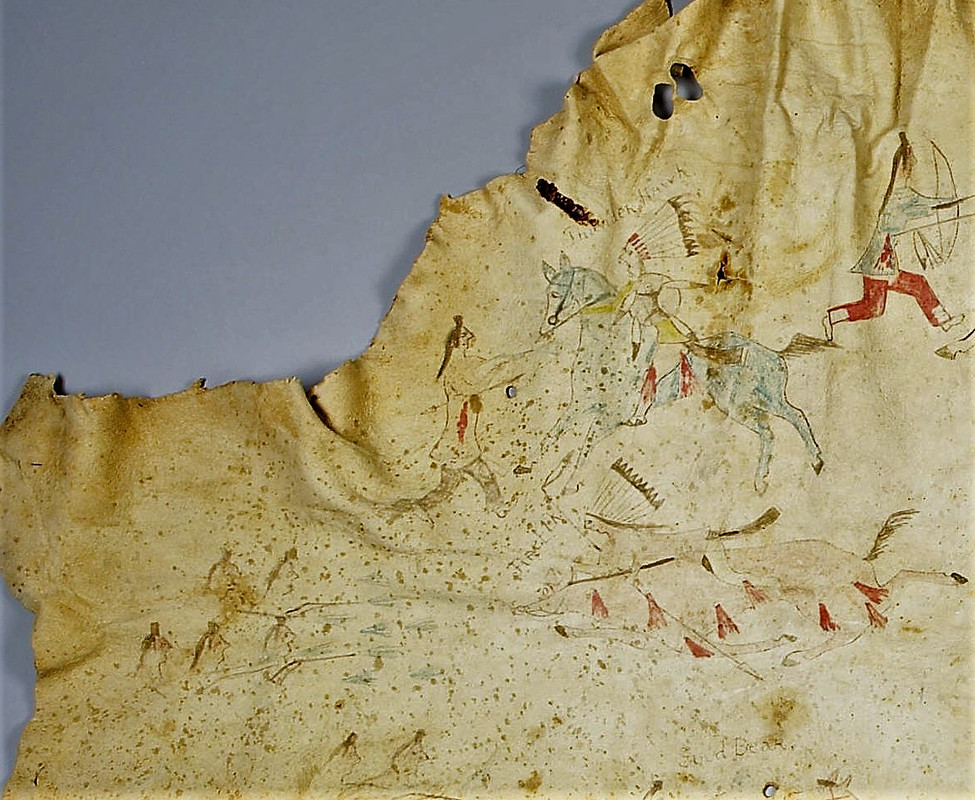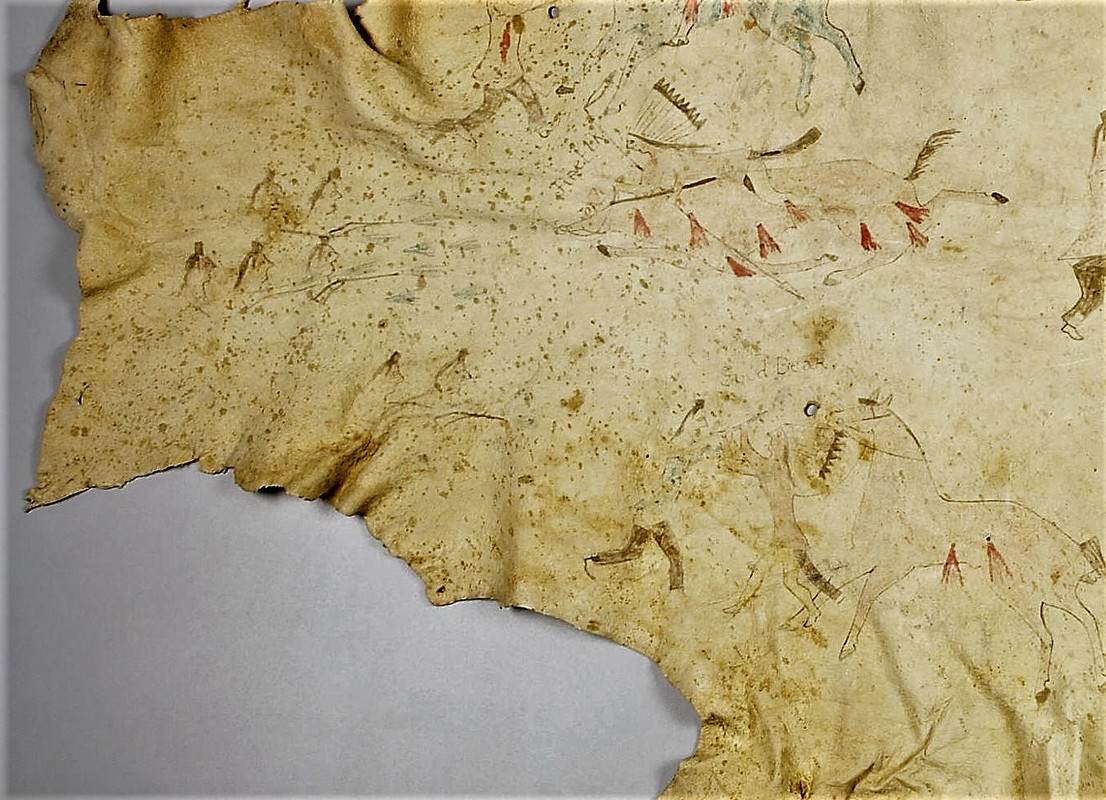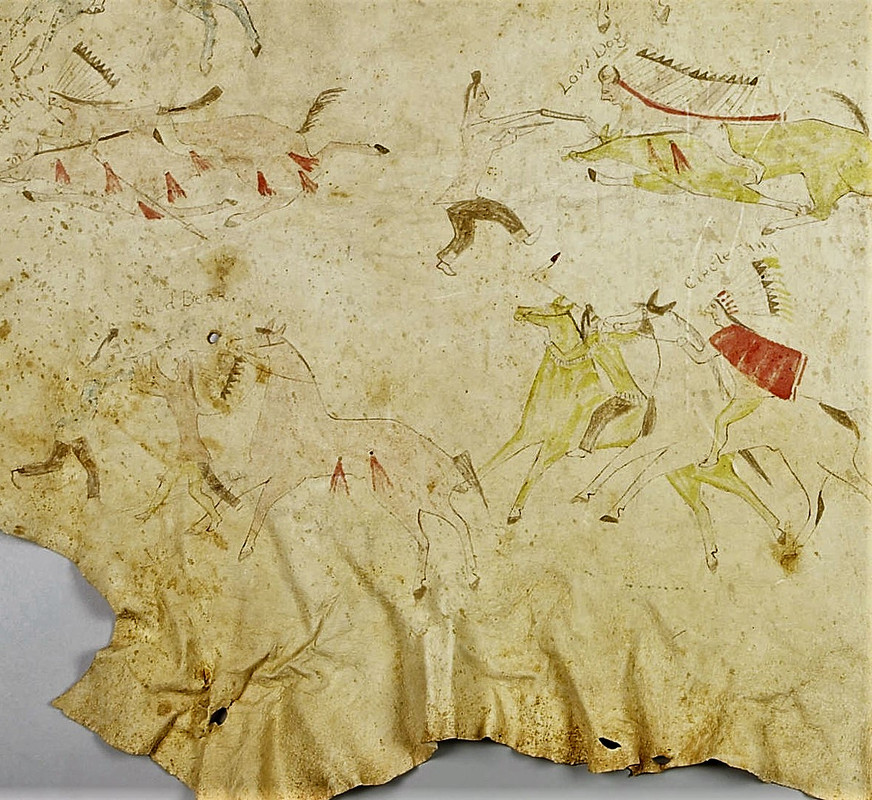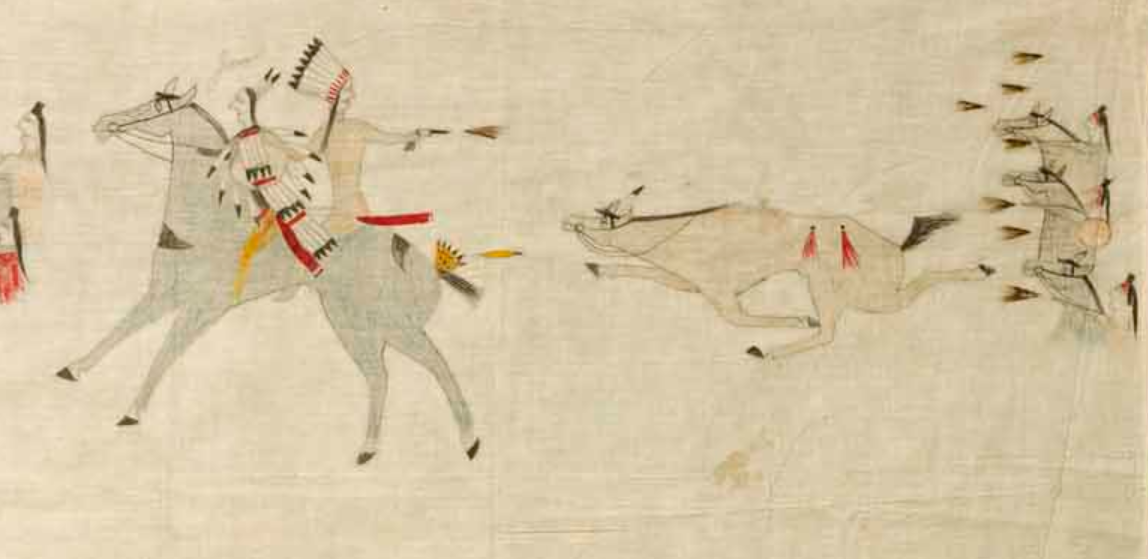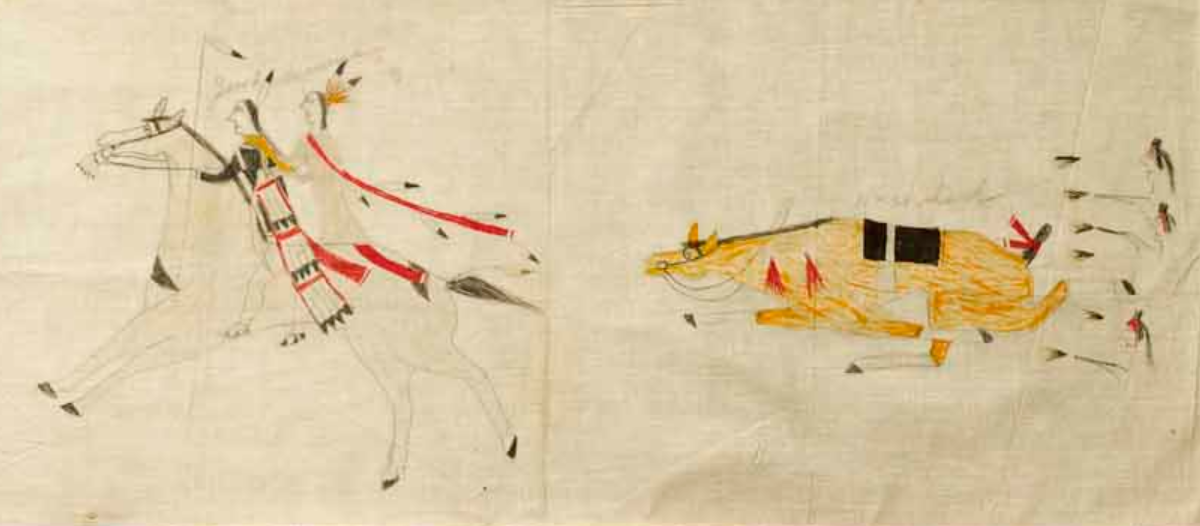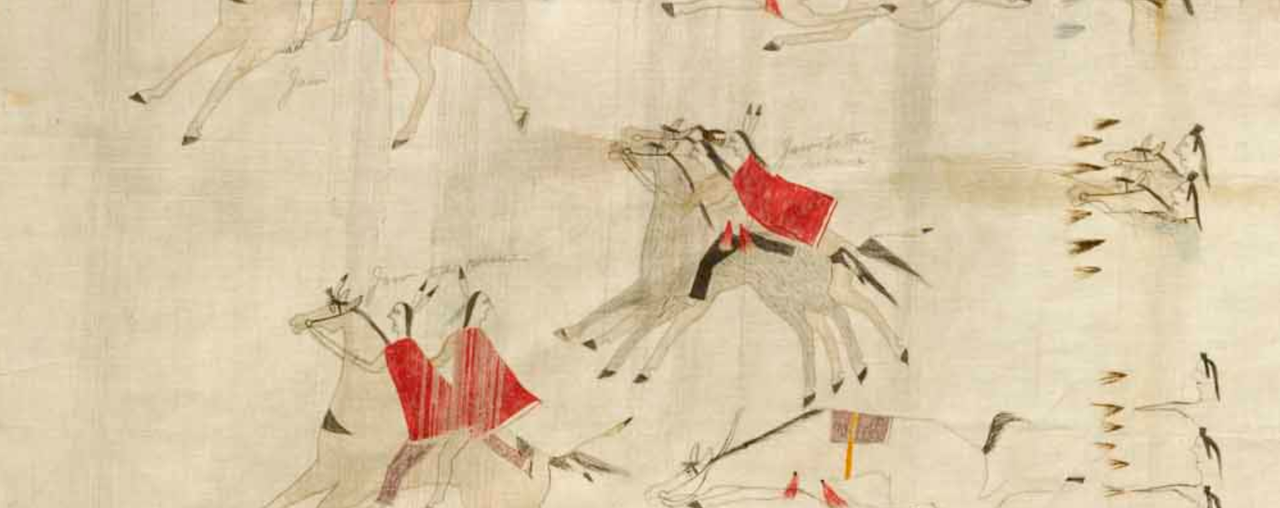Post by grahamew on Apr 27, 2011 7:58:26 GMT -5
Taken from the Heritage Auction site: a robe painted by Jaw dated ca 1890), one of Densmore's informants and a noted artist, of the Battle of Rainy Butte, 1859, when a party of Crow attacked a group of Hunkpapa, who then rallied with the aid of some Sans Arc and Miniconjou to drive them off. This was the battle where Jumping Bull, Sitting Bull's father was killed, and after which, in acknowledgement of his courage and success on the field, the Hunkpapa, Burns the Medicine Bundle, became known as Crow King. Some of the pictures below have also been posted in the Low Dog thread.

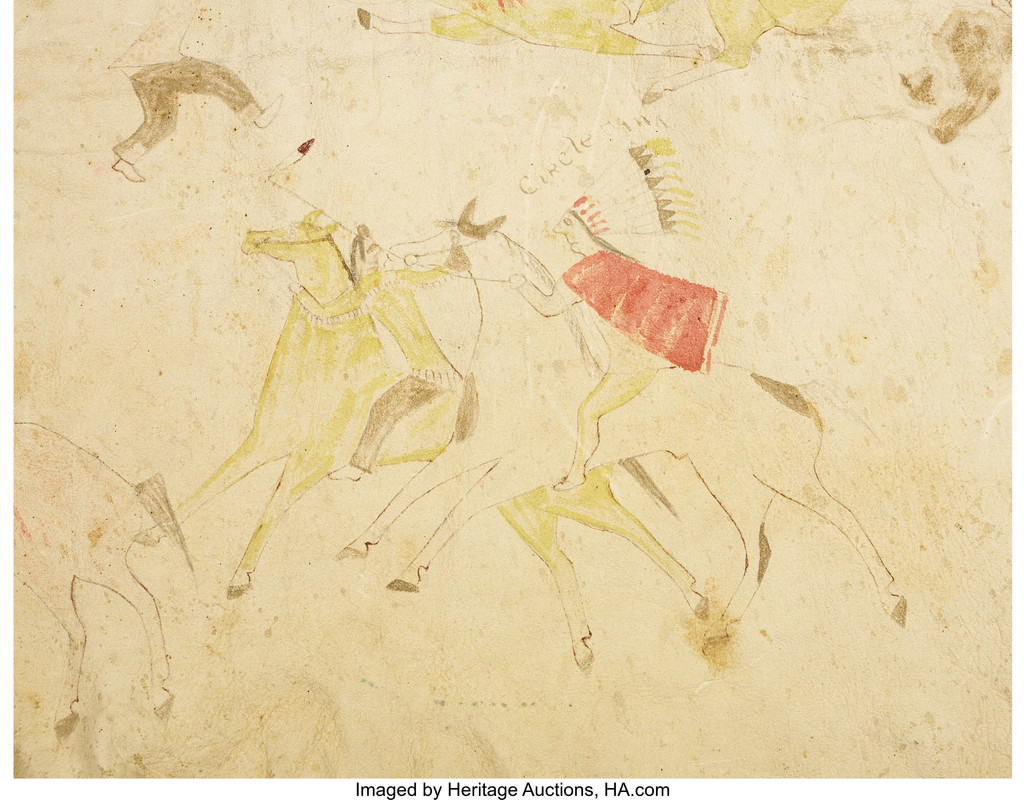
From Heritage Auctions:
A SIOUX PICTORIAL PAINTED HIDE ROBE
SAM JAW
c. 1890
rendered in blue, red, yellow, green, rust and black pigments, one side depicting a frenzied battle with Jaw and his fellow Hunkpapa warriors in deadly combat with the Crow Indians, the other side, with two portraits of the artist, one on the left, fulfilling his Sun Dance vows, wood skewers piercing his chest, bound by rawhide to the center pole, and on the right, standing next to his horse, ready for battle
This painting most likely depicts the Battle of Rainy Butte in the Spring of 1859 in which Sitting Bull (top center) is seen killing a Crow with a lance, avenging the death of his father, Jumping Bull. The Hunkpapa camp was attacked by about fifty Crow warriors at daylight. The Sioux collected themselves and eventually drove off and pursued the Crow, killing ten of them. When the Crow fled, they left behind three women and a baby boy. To the lower right we see the young Crow child being carried off by Shoots-The-Enemy.
All of the participants are mentioned by name, including Good Bear, Fire Elk, Thunder Hawk, Low Dog, Circle Hawk, Catch-The-Bear, Shoots-The-Enemy, Charging Bear, and Walking Shoot (aka Shoots Walking). For a detailed account of the Battle of Rainy Butte, see: Vestal, Stanley, Sitting Bull, U. of Oklahoma Press, Norman, 1957, pp. 43 - 49, and Utley, Robert, The Lance and the Shield: The Life and Times of Sitting Bull, Ballantine Books, NY 1993, pp. 24 - 25.
Our knowledge of the artist comes to us from the writings of the noted ethnomusicologist Frances Densmore, who interviewed Jaw in 1913 when he was 63 years old. "Jaw's manner of painting himself and his horse when going on the war path was as follows: he painted a red crescent over his mouth, the points of the crescent extending upward half way up to his cheekbones. His hands were painted red from the wrists and his feet from the ankles. A large crescent like that on his face was painted on his horse's chest, and a smaller one on the animal's left hip, while the entire end of the horse's nose was painted yellow. If a horse succeeded in some difficult undertaking it was his custom to reward the animal by putting a feather in it's mane or tail, or a band of red list-cloth around its neck," Densmore, Frances, Teton Sioux Music, Smithsonian Institution Bureau of American Ethnology, Bulletin 61, Washington, 1918, pp. 387 - 393 and plates 59 - 63.
Another example of the artist's work appears in Spendid Heritage. The muslin painting illustrated is likely another version of the Battle of Rainy Butte. Here again we see Jaw wearing a cape of red wool save list cloth and coming to the rescue of his comrades. Further, this painting is useful for stylistic comparison, especially Jaw's treatment of wounded horses. See Batkin, Jonathan, ed., Spendid Heritage, Wheelwright Museum of the American Indian, Santa Fe, 1995, pp. 38- 39
fineart.ha.com/common/view_item.php?SaleNo=681&LotIdNo=7010
Here's the reverse:
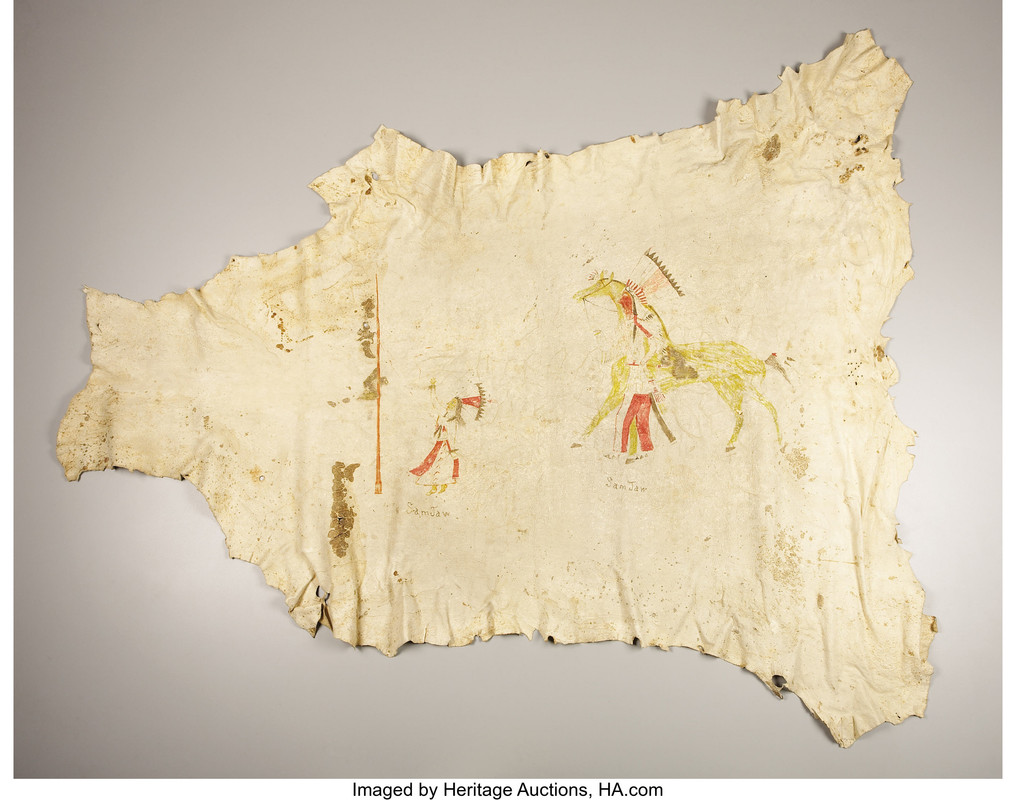


From Heritage Auctions:
A SIOUX PICTORIAL PAINTED HIDE ROBE
SAM JAW
c. 1890
rendered in blue, red, yellow, green, rust and black pigments, one side depicting a frenzied battle with Jaw and his fellow Hunkpapa warriors in deadly combat with the Crow Indians, the other side, with two portraits of the artist, one on the left, fulfilling his Sun Dance vows, wood skewers piercing his chest, bound by rawhide to the center pole, and on the right, standing next to his horse, ready for battle
This painting most likely depicts the Battle of Rainy Butte in the Spring of 1859 in which Sitting Bull (top center) is seen killing a Crow with a lance, avenging the death of his father, Jumping Bull. The Hunkpapa camp was attacked by about fifty Crow warriors at daylight. The Sioux collected themselves and eventually drove off and pursued the Crow, killing ten of them. When the Crow fled, they left behind three women and a baby boy. To the lower right we see the young Crow child being carried off by Shoots-The-Enemy.
All of the participants are mentioned by name, including Good Bear, Fire Elk, Thunder Hawk, Low Dog, Circle Hawk, Catch-The-Bear, Shoots-The-Enemy, Charging Bear, and Walking Shoot (aka Shoots Walking). For a detailed account of the Battle of Rainy Butte, see: Vestal, Stanley, Sitting Bull, U. of Oklahoma Press, Norman, 1957, pp. 43 - 49, and Utley, Robert, The Lance and the Shield: The Life and Times of Sitting Bull, Ballantine Books, NY 1993, pp. 24 - 25.
Our knowledge of the artist comes to us from the writings of the noted ethnomusicologist Frances Densmore, who interviewed Jaw in 1913 when he was 63 years old. "Jaw's manner of painting himself and his horse when going on the war path was as follows: he painted a red crescent over his mouth, the points of the crescent extending upward half way up to his cheekbones. His hands were painted red from the wrists and his feet from the ankles. A large crescent like that on his face was painted on his horse's chest, and a smaller one on the animal's left hip, while the entire end of the horse's nose was painted yellow. If a horse succeeded in some difficult undertaking it was his custom to reward the animal by putting a feather in it's mane or tail, or a band of red list-cloth around its neck," Densmore, Frances, Teton Sioux Music, Smithsonian Institution Bureau of American Ethnology, Bulletin 61, Washington, 1918, pp. 387 - 393 and plates 59 - 63.
Another example of the artist's work appears in Spendid Heritage. The muslin painting illustrated is likely another version of the Battle of Rainy Butte. Here again we see Jaw wearing a cape of red wool save list cloth and coming to the rescue of his comrades. Further, this painting is useful for stylistic comparison, especially Jaw's treatment of wounded horses. See Batkin, Jonathan, ed., Spendid Heritage, Wheelwright Museum of the American Indian, Santa Fe, 1995, pp. 38- 39
fineart.ha.com/common/view_item.php?SaleNo=681&LotIdNo=7010
Here's the reverse:





